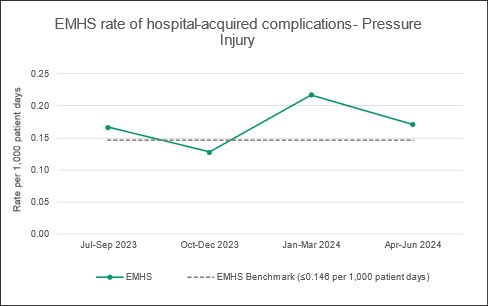Hospital-acquired complications – Pressure injury
A pressure injury is a sore, break or blister of the skin caused by unrelieved pressure or friction on an area of the body over a period of time. The depth of skin damage can vary from shallow to very deep. Pressure injuries can be very painful and take a long time to heal. They may also reduce a patient’s mobility.
Older people are at most risk of pressure injuries, but they can occur in any patient or in any setting, including:
- acute areas such as operating theatres
- during transportation to a hospital
- intensive care units.
The majority of pressure injuries are preventable; however those at greater risk include the frail, elderly or people who have:
- been confined to a bed or chair
- poor bladder or bowel control
- diabetes, poor circulation or a history of smoking
- reduced mental awareness due to illness, medications or anaesthetics
- poor diet or fluid intake.
Pressure injuries may impact significantly on a patient’s:
- length of hospital stay
- comfort and quality of life
- cost of care and health outcomes.
Measuring hospital-acquired complications – Pressure injury
The international pressure injury classification systems provide a consistent and accurate means to communicate and document the severity of a pressure injury between clinical staff. The classification system grades these types of wounds in stages depending on:
- changes in the patient’s skin
- the depth of the injury
- whether there is any fluid draining from the wound.
Healthcare commonly uses rates to measure complications such as these. The number of patients who developed one or more Stage 3 or greater pressure injuries during their hospital stay per 1,000 patient days.
How do we measure up
The graph below shows the combined inpatient pressure injury rate for the EMHS hospitals:
- Armadale Health Service
- Kalamunda Hospital
- Bentley Hospital
- Royal Perth Hospital
- St John of God Midland Public Hospital
Chart: Rate of hospital-acquired pressure injuries.

What the figures mean
The benchmark is less than or equal to 0.146 hospital-acquired pressure injury per 1,000 patient days. A rate lower than the benchmark is desirable. EMHS constantly strives to reduce the rate of hospital-acquired pressure injury across all EMHS hospitals and preventative strategies continue to be put in place.

